Have you ever wondered what incredible Birds of Prey soar through the skies of Florida, dominating the natural food chain? From their awe-inspiring hunting skills to their remarkable adaptations, Florida Birds of Prey have captivated bird enthusiasts for generations. But which birds of prey call the Sunshine State their home, and what makes them so fascinating? Ready to be amazed as we get into the world of these majestic predators and uncover the secrets of their survival.
1. Bald Eagle
The bald eagle, which serves as the national symbol of the United States, isn’t bald, despite its name, and shares its iconic status with the Turkey Vulture, a vital part of the ecosystem. It’s called bald because of its striking white-feathered head, a feature that makes it one of the most recognizable birds of prey in Florida.
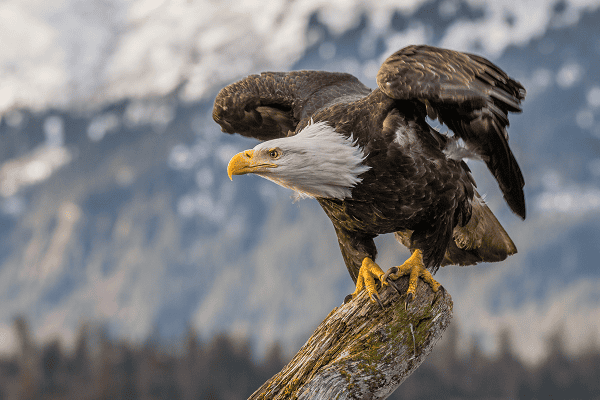
Furthermore, male bald eagles typically weigh between 3.5 to 4 kilograms, while females weigh between 4.5 to 6 kilograms. On average, they stand about 3 feet tall and boast an impressive wingspan of 7 feet.
Moreover, the distinguishing features of bald eagles include a white head and tail, a brown body, and a large, curved yellow bill. Juvenile bald eagles have white blotchy patches on their tail and underside.
Besides this, bald eagles prefer habitats near lakes, coastlines, rivers, or wet prairies. They primarily hunt for swimming fish but also prey on wading birds, small mammals, waterfowl, and carrion.
Plus, bald eagles breeding in the North migrate south during early winter to find food when their hunting grounds freeze over, much like the Short-tailed Hawk, a seasonal visitor to Florida. They return to their breeding areas when the weather improves and prey becomes more plentiful.
| Characteristic | Description |
|---|---|
| Scientific Name | Haliaeetus leucocephalus |
| Coloration | Brown body with a distinctive white head and tail |
| Wingspan | Up to 7 feet |
| Diet | Primarily fish, but also small mammals and birds |
| Habitat | Coastlines, lakes, and rivers |
| Status | Protected species, symbol of American freedom |
As we continue our journey exploring the diverse array of Florida Birds of Prey, the Bald Eagle remains a true icon of both power and grace. Its presence in Florida’s skies reminds us of the beauty and strength of nature, making it a bird that truly deserves our admiration.
2. Red-shouldered Hawk
The Red-shouldered Hawk is a fascinating bird of prey that can be found throughout Florida. With its distinctive reddish-brown plumage, striking red shoulders, and piercing calls, this hawk is truly a sight to behold.

This magnificent predator, akin to the Sharp-shinned Hawk and other predatory birds in Florida, primarily feeds on small mammals and birds, using its keen eyesight and powerful talons to hunt and capture its prey. Its presence in Florida, especially in southern regions, plays a vital role in maintaining the delicate balance of the avian prey species within the ecosystem, epitomizing the critical role of Florida’s raptors.
The Red-shouldered Hawk’s ability to adapt to various habitats makes it a versatile and successful hunter. This hawk can be found in forests, wetlands, and suburban areas, showcasing its adaptability and resilience.
When observing the Red-shouldered Hawk in flight, it’s broad wingspan and graceful movements are a testament to its aerial prowess. This bird of prey soars effortlessly through the sky, gliding on thermal updrafts in search of its next meal.
Red-shouldered Hawks are known for their distinctive call, a vocalization that is often described as a clear, high-pitched whistle, not unlike the haunting call of the Black Vulture in the evening sky. This call, a distinctive sound among the birds of prey in Florida, can be heard throughout the day, especially during the breeding season when these hawks engage in courtship displays.
As I’ve had the privilege of observing this majestic bird in its natural habitat, I can confidently say that the Red-shouldered Hawk is a true symbol of Florida’s diverse wildlife and a testament to the beauty and resilience of these incredible creatures.
3. Swallow-tailed Kite
The Swallow-tailed Kite The Crested Caracara is a migratory bird of prey that graces the skies of Florida during the breeding season. With its striking black and white plumage and deeply forked tail, the Mississippi Kite stands out as one of the most distinctive raptors in the state. Watching this graceful bird soar through the air is truly a captivating sight.
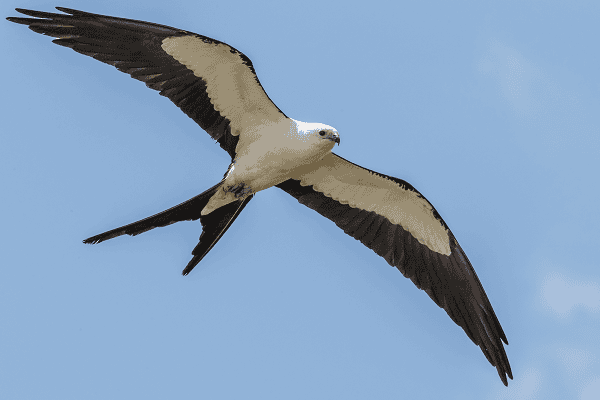
The Swallow-tailed Kite’s diet consists primarily of insects, making it an invaluable ally in controlling pest populations. From dragonflies to grasshoppers, this avian insectivore keeps the delicate balance of Florida’s ecosystem in check. Its agile flight and exceptional hunting skills allow it to snatch its prey mid-air with precision and ease.
“The Swallow-tailed Kite’s aerobatic abilities and elegant appearance make it a true icon of Florida’s birding world. Its presence in the skies provides both seasoned birdwatchers and nature enthusiasts alike with a sense of wonder and appreciation for the beauty of our natural surroundings.” – Birding enthusiast
While the Swallow-tailed Kite is a migratory species, Florida’s diverse and abundant wetlands, marshes, and forests offer the perfect breeding ground for these magnificent birds. As they raise their young and teach them to navigate the skies, they contribute to the rich biodiversity that makes Florida a haven for birdlife.
Conservation efforts and habitat preservation play a crucial role in ensuring the continued presence of the broad-winged hawk and other Florida raptors. Swallow-tailed Kite in Florida. By understanding and protecting these remarkable birds, we can enjoy their aerial displays and appreciate their vital role in maintaining the delicate balance of our ecosystems.
4. Great Horned Owl
The Great Horned Owl The Red-tailed Hawk is a formidable nocturnal predator that inhabits various habitats across Florida. With its impressive size, distinctive ear tufts, and powerful talons, this owl is a skilled hunter capable of capturing a wide range of prey. Its presence contributes to the diverse wildlife landscapes of the state.
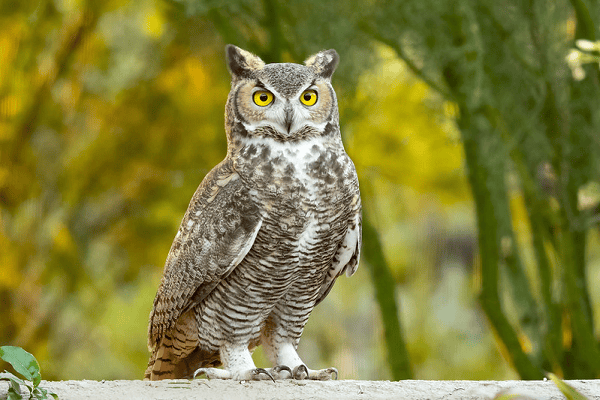
The Florida Birds of Prey category is incomplete without mentioning the Great Horned Owl. As an apex predator, it plays a crucial role in maintaining the balance of the ecosystem. This bird of prey diligently preys on small mammals, birds, and even other owls, making it a formidable force in the avian community.
“The Great Horned Owl is a master of stealth and camouflage, using its mottled feathers to blend seamlessly into its surroundings. Its keen hearing, enhanced by the unique placement of its ear tufts, allows it to locate prey even in complete darkness.”
This magnificent owl’s conservation status is of particular interest because of its vital ecological role. By controlling rodent populations, the Great Horned Owl helps maintain the health and balance of diverse ecosystems in Florida.
Ecosystem Impacts
Apart from their role as natural predators, Great Horned Owls have fascinating interactions with other species, similar to the Snail Kite, which is known for its unique dietary preference in Florida. Their large nests, constructed in the abandoned nests of other large birds, provide shelter for various animals. Additionally, their prey remains contribute to nutrient cycling in the ecosystem, benefiting scavengers and decomposers.
Adaptations
One of the notable adaptations of the Great Horned Owl is its silent flight. The fringed edges of its feathers reduce air turbulence, allowing it to approach prey silently. Its exceptional hearing ability, due to the unique placement of its ear tufts, gives the owl an advantage in locating prey with remarkable accuracy.
Conservation Challenges
Despite its adaptability and widespread distribution, the Great Horned Owl faces conservation challenges in Florida. Habitat loss and fragmentation, as well as collisions with vehicles and human infrastructure, pose significant threats. Efforts to preserve and restore suitable habitats are crucial for ensuring the long-term survival of this majestic bird of prey, a mission that the Center for Birds of Prey and the Audubon Center for Birds fervently support.
5. Peregrine Falcon
The Peregrine FalconThe White-tailed Kite, also known as a master of the skies in South Florida, plays a crucial role in the region’s ecosystem. Falco peregrinus is a magnificent bird of prey that can be found globally, including in Florida. Renowned as one of the fastest birds in the world, the Peregrine Falcon can reach mind-boggling speeds exceeding 240 miles per hour during its hunting dives. This incredible speed and agility enable it to swiftly chase down its prey with precision and grace.
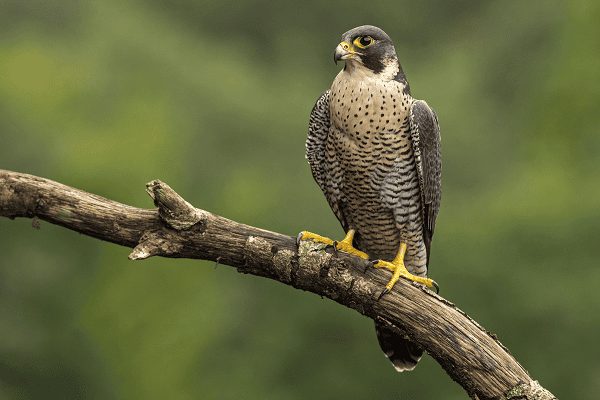
In Florida, the Peregrine Falcon migrates to the state for breeding purposes. Its presence adds to the diverse population of Florida Birds of Prey, enriching the wildlife landscape and captivating birdwatchers and nature enthusiasts alike. Seeing a Peregrine Falcon in action is a breathtaking experience, as it soars through the sky with unmatched speed and power.
The Peregrine Falcon is known for its distinctive features, including its sharp, curved beak and fierce, piercing eyes that help it spot prey from great distances. Its plumage varies depending on age and geographic location, but it typically includes a combination of dark and light feathers that enhance its camouflage while hunting.
Witnessing a Peregrine Falcon in its natural habitat is a true testament to the magnificence of nature. The speed, agility, and hunting prowess of these birds, including the Broad-winged Hawk and the Sharp-shinned Hawk, are nothing short of extraordinary.
Falco peregrinus primarily feeds on smaller birds, such as pigeons and smaller songbirds, but it also preys on bats and occasionally small mammals. It is known for hunting by stooping, which involves folding its wings and diving at incredible speeds to surprise and capture its prey.
Conservation efforts for the Peregrine Falcon have been crucial to protect its population, as it faced severe declines in the past due to habitat loss and the use of pesticides. Thankfully, these efforts have resulted in successful recovery, and the Peregrine Falcon now serves as a symbol of conservation and resilience.
The Peregrine Falcon’s presence in Florida reminds us of the diversity of avian species that inhabit the state. Its speed, agility, and remarkable hunting abilities make it a truly remarkable bird and a testament to the beauty of Florida’s Birds of Prey.
6. American Kestrel
The American Kestrel, also known as a kestrel, is a small but mighty falcon found in various parts of Florida. With its colorful plumage and exceptional hovering skills, it captivates birdwatchers. This kestrel feeds on small mammals, birds, and insects, contributing to a healthy balance in Florida’s ecosystems.
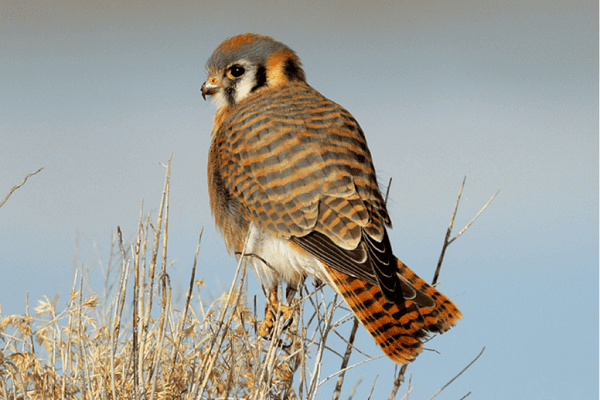
Despite its small size, the American Kestrel is a skilled predator and an agile hunter. Its vibrant plumage, consisting of rust-colored back feathers and stunning blue wings and head, makes it a striking sight as it soars across the Florida skies. The male kestrel is particularly eye-catching with its slate blue wings and reddish back.
“The American Kestrel is a true marvel of nature, combining beauty and predatory prowess in its compact frame,” says Dr. Rachel Thompson, an ornithologist specializing in Florida birds of prey. She adds, “The kestrel’s ability to hover motionless in the air while scanning its surroundings for prey is truly remarkable.”
One of the kestrel’s most impressive hunting techniques is its ability to hover in mid-air, rapidly flapping its wings to maintain a steady position while searching for prey below. Once it spots its target, the kestrel will dive down with astonishing speed, seizing its prey in its sharp talons before returning to a perch to eat. Its diet includes small mammals such as mice and voles, as well as birds and insects.
This falcon’s presence in Florida is crucial for maintaining a healthy balance in the ecosystem. By keeping small mammal and insect populations in check, the American Kestrel plays a vital role in preserving the delicate ecological harmony of the state.
American Kestrel in Florida
Florida’s diverse habitats, including wetlands, prairies, and forests, provide an ideal home for the American Kestrel. This adaptable bird of prey can be found in both urban and rural areas, making it accessible for birdwatchers across the state.
| Characteristics | Details |
|---|---|
| Size | 7-11 inches in length |
| Wingspan | 20-24 inches |
| Coloration | Male: slate blue wings, reddish back, and blue-gray head; Female: brown wings and back, with a barred tail |
| Habitat | Open and semi-open areas, including fields, grasslands, and agricultural lands |
| Food | Small mammals, birds, and insects |
As an efficient predator and an integral part of Florida’s avian community, the American Kestrel serves as a valuable indicator of the state’s overall ecosystem health. Protecting its habitat and preserving its prey sources are vital for ensuring the long-term survival of this beautiful falcon.
7. Osprey
The Osprey, also known as a fish eagle or fish hawk, is a magnificent bird of prey that is frequently sighted near coastal areas in Florida. With its captivating presence and unique hunting techniques, the White-tailed Kite exemplifies the diversity of predatory birds in Florida. Osprey is a prominent member of the Florida Birds of Prey.
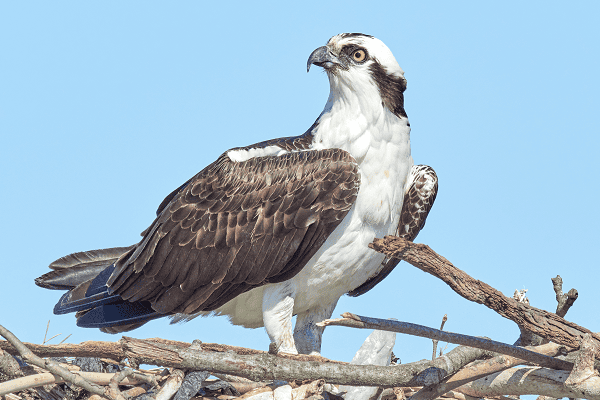
One of the Osprey’s most remarkable abilities is its skillful diving technique, a trait it shares with the Mississippi Kite, known for its aerial acrobatics. When hunting for fish, the Osprey soars high above the water, scanning for its prey with sharp eyesight. Once it spots a fish near the water’s surface, it dramatically plunges into the water, extending its talons to capture its meal with unparalleled precision, much like the hunting techniques of other birds of prey in Florida.
This skill is made possible by the Osprey’s exceptional physical adaptations. Its long, curved talons and reversible outer toes allow it to smoothly grip slippery fish, characteristic of the superior hunting adaptations found in Florida raptors. The Osprey’s plumage is also uniquely designed to repel water, ensuring it remains buoyant and dry even after diving into the ocean.
The Osprey’s hunting prowess not only satisfies its own hunger but also contributes to the overall health of Florida’s marine ecosystems. By regulating fish populations, the Osprey helps maintain a balanced ecosystem, ensuring the sustainability of various aquatic species.
The Osprey’s ability to dive into the water to catch fish is truly awe-inspiring. Witnessing this majestic bird in action is an unforgettable experience that highlights the remarkable adaptations and critical role of Florida’s Birds of Prey.
8. Cooper’s Hawk
The Cooper’s Hawk is a fascinating medium-sized hawk that can be found in various habitats across Florida. With its incredible agility and adaptability, this hawk has carved out its place in the avian predator community of the state.

One of the remarkable traits of the Cooper’s Hawk is its ability to maneuver through dense vegetation. This allows it to surprise and capture its prey, which primarily consists of small birds and mammals. Its sharp talons and keen eyesight aid in its successful hunts, making it a formidable predator in the skies of Florida.
The Cooper’s Hawk’s presence in Florida is crucial for maintaining the balance of the ecosystem, showcasing the importance of Florida raptors. By controlling the populations of small birds and mammals, this hawk plays a vital role in ensuring the stability and health of avian prey species in the region.
Check Our Previous Articles:
| Hawks in Georgia |
| Are Red Peacock Real or Fake |
| Cardinals Appear When Angels Are Near |
| Duck Hunting Season in Michigan |
Frequently Asked Questions:
Q1. Are there birds of prey in Florida?
Yes, Florida is home to various birds of prey, including hawks, eagles, owls, and falcons.
Q2. What is the largest predatory bird in Florida?
The Bald Eagle holds the title of the largest predatory bird in Florida.
Q3. What bird is Florida known for?
Florida is renowned for its population of Flamingos, which are iconic birds often associated with the state.
Q4. Does Florida have falcons?
Yes, Florida is home to several species of falcons, including the Peregrine Falcon and the American Kestrel.

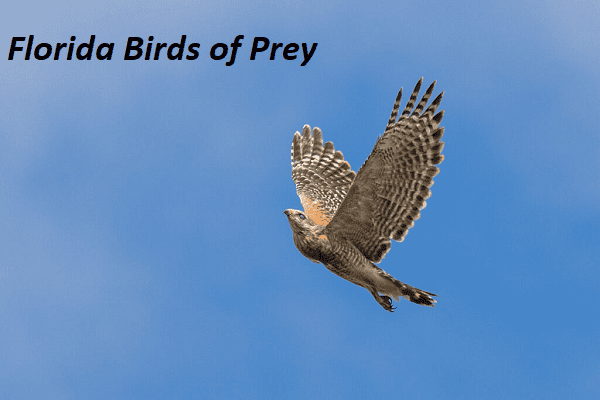

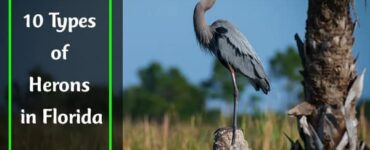
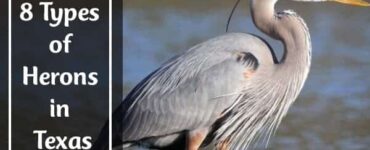
Add comment